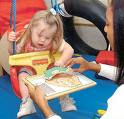
Ultrasounds and detecting Down Syndrome Ultrasound tests can be done in the first trimester to check for early signs of Down's Syndrome, such as thicker than normal neck skin.Ultrasound tests are frequently performed not only to check on the progression of the pregnancy, but to find out the baby's gender and size.In addition, of course, babies move around like mad as any pregnant lady who's tried to sleep through a kicking child can attest.While testing procedures have improved greatly, keep this small chance in mind when looking at test results.
The mother will be moving slightly during the test, no matter how hard she tries to be still.This risk is why avoiding them as much as possible is a good idea.Ultrasound is not a definitive test for a number of reasons.
Use of ultrasound and maternal blood testing can help avoid the necessity of the more definitive tests.Retrieved from "http://www.Amniocentesis involves taking a sample of amniotic fluid from within the placental sac.Sceening the baby more invasively Be aware that these tests carry a small risk of endangering the baby and the mother because all of them involve physically invading the uterus for a tissue sample.Because these tests involve breaching the integrity of the uterus and/or placental fluid sac, they have a small chance of causing a miscarriage or other damage.False positives are maddening, stressful errors in the testing process, and can lead new parents to believe they have a child with Down's Syndrome when, in fact, they don't.
However, if screening up to this point has indicated a strong possibility of Down's Syndrome in your baby, you may want to go ahead and have the more definitive tests done to get a real, concrete answer.Children with Down's Syndrome are, first and foremost, children, with all the capacity for love, wonder and life implied thereby.These tests include umbilical cord blood testing, sampling of placental tissue, and amniocentesis.Her breathing moves her uterus, if nothing else.Maternal Blood Screening If the ultrasounds indicate that the unborn baby may have Down's Syndrome, maternal blood screening is a good next step.While ultrasound testing is usually a lovely bonus for any parent, these tests can be invaluable life-savers to parents who believe their child to be at risk for Down's Syndrome.These blood tests are taken from Mom and look for several factors in her blood that indicate potential Down's Syndrome.
In addition to advances in ultrasound, maternal blood screening tests have advanced to the point where more dangerous procedures can frequently be avoided.As diagnosis occured before birth, you have the opportunity to maximize your child's capability, potential and quality of life.Because ultrasound testing involves bouncing sound waves in order to get a clear picture, movement can give false results either way.However, these early ultrasound tests can help both doctors and parents make informed decisions to proceed or not with further Down's Syndrome tests.
Conclusion If the tests should come up positive, realize that your child can enjoy a happy and full life with early intervention and loving care.In the early second trimester, an ultrasound test may be able to show another potentially problematic sign, the lack of a normal nasal bone.Combining ultrasound and maternal blood tests The combination of ultrasound and maternal blood testing increases the odds of early detection to 90% with only 5% erroneous positive results of detecting down syndrome.


